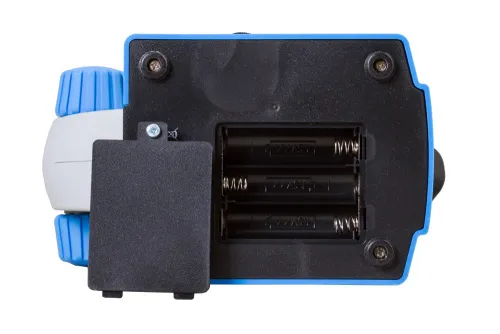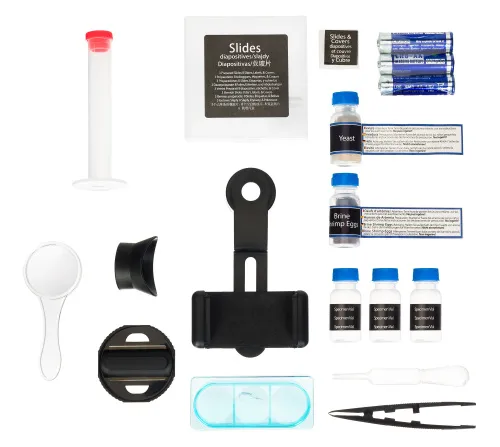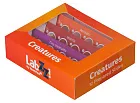Bresser Junior 40–640x Microscope
Colorful kid’s microscope. Experiment kit included. Magnification: 40–640x
| Product ID | 70123 |
| Brand | Bresser GmbH, Germany |
| Warranty | 2 years |
| EAN | 4007922033747 |
| Package size (LxWxH) | 28x15x17 cm |
| Shipping Weight | 0.86 kg |
Bresser Junior 40–640x kid’s microscope is the best choice for the first microscope for a curious kid. This simply controlled instrument with vibrant body will engage your kid for quite a while. The microscope is very easy to use; it allows for studying transparent microscope samples, and also comes with an interesting experiment kit. A kid will be able to observe ready-to-use microscope slides and watch Artemia’s growth in a hatchery. The kit also includes special tools for independent preparation of microscope samples. All this will let your child feel like a real scientist!
Bresser Junior 40–640x Microscope is equipped with three objectives lenses, which allow for 40–640x magnification range. To change the magnification, you don’t have to pause your work – you can quickly switch objectives using the revolving nosepiece. The unique feature of this model is its sliding two-position eyepiece, which replaces two eyepieces with an increase of 10 and 16-fold – and it is really easy to use. Your kid won’t need to change eyepieces; therefore they won’t get lost.
To observe a fly's wing or onion cells, a thin transparent sample should be placed on the round stage. Convenient clips will securely hold it in place – you won't lose it out of sight after a careless movement. The light emitted from LED diodes (located below the stage) passes through the sample, creating the magnified image. The adjustable brightness is a very convenient feature – you can make the illumination more intensive for thick and less transparent samples, and do otherwise when observing very thin and very transparent sections. The LED illumination is powered by batteries, meaning the microscope can be used not just at home and at school, but also outdoors.
Bresser Junior 40–640x Microscope comes with experiment kit, which has everything needed to make first observations frustration-free and exciting. You can begin with observing ready-to-use microscope samples included in the kit and then move on to creating your own microscope slides. In the box you will find a set of helpful instruments and a detailed user guide with all required information on microscopes and observations as well as descriptions of the most interesting experiments.
Features:
- Kid’s microscope with vibrant body color
- LED lighting
- Illumination intensity adjustment
- Durable and lightweight body
- Experiment kit in the package
The kit includes:
- Bresser Junior 40–640x Microscope
- 3 ready-to-use specimens
- 8 blank slides
- 8 cover slips
- 8 stickers for slides
- Flask with yeast
- Flask with brine shrimp
- Hatchery for Artemia (brine shrimp)
- 3 flasks
- Microtome
- Forceps
- Dropper
- Loupe
- Measuring cup
- 3 AA batteries
- User manual
| Product ID | 70123 |
| Brand | Bresser GmbH, Germany |
| Warranty | 2 years |
| EAN | 4007922033747 |
| Package size (LxWxH) | 28x15x17 cm |
| Shipping Weight | 0.86 kg |
| Type | biological, light/optical |
| Microscope head type | monocular |
| Magnification, x | 40 — 640 |
| Eyepieces | WF10x–16x (two-position) |
| Revolving nosepiece | for 3 objectives |
| Stage features | with clips |
| Diaphragm | diaphragm disc |
| Focus | coarse |
| Body | plastic |
| Illumination | LED |
| Brightness adjustment | ✓ |
| Power supply: batteries/built-in battery | 3 AA batteries (included) |
| User level | elementary |
| Application | elementary |
| Illumination location | lower |
| Research method | bright field |
| Experiment kit included | ✓ |
and downloads
We have gathered answers to the most frequently asked questions to help you sort things out
Find out why studying eyes under a microscope is entertaining; how insects’ and arachnids’ eyes differ and what the best way is to observe such an interesting specimen
Read this review to learn how to observe human hair, what different hair looks like under a microscope and what magnification is required for observations
Learn what a numerical aperture is and how to choose a suitable objective lens for your microscope here
Learn what a spider looks like under microscope, when the best time is to take photos of it, how to study it properly at magnification and more interesting facts about observing insects and arachnids
This review for beginner explorers of the micro world introduces you to the optical, illuminating and mechanical parts of a microscope and their functions
Short article about Paramecium caudatum - a microorganism that is interesting to observe through any microscope























